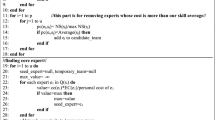Abstract
This paper studies the team formation problem, which includes a social collaboration network and a project, comprised of a number of tasks, each requiring a particular skill. The goal is to select the most appropriate members for the team, who not only cover the required project skills, but also have the highest degree of expertise according to the team cost. This study presents a more comprehensive initial definition of team formation in which each task is performed by a specific number of experts. Moreover, a method is proposed, which selects the best team, such that the selected members have the highest degree of cooperation for each task. The distance function is also changed to provide a more logical calculation of the shortest path between experts. Furthermore, some team members have more relationships with others, which makes them more important members in a team. This is an important factor in computing the communication cost of team members. Empirical results on DBLP dataset show the superiority of the proposed approach. Moreover, the proposed method reduces project risk by considering team members’ levels of expertise and insures the success of the given project.















Similar content being viewed by others
References
Al Hasan M, Zaki MJ (2011) A survey of link prediction in social networks. In: Aggarwal C (eds) Social network data analytics. Springer, Boston, pp 243–275
Anagnostopoulos A, Becchetti L, Castillo C, Gionis A, Leonardi S (2012) Online team formation in social networks. In: Proceedings of the 21st international conference on world wide web. ACM, New York, pp 839–848
Appel AP, Cavalcante VF, Vieira MR, de Santana VF, de Paula RA, Tsukamoto SK (2014) Building socially connected skilled teams to accomplish complex tasks. In: Proceedings of the 8th workshop on social network mining and analysis. ACM, New York, p 8
Ashenagar B, Hamzeh A, Eghlidi NF, Afshar A (2015) A fast approach for multi-objective team formation in social networks. In: 2015 7th conference on information and knowledge technology (IKT), pp 1–6
Awal GK, Bharadwaj K (2014) Team formation in social networks based on collective intelligence-an evolutionary approach. Appl Intell 41(2):627–648
Batagelj V, Zaversnik M (2003) An \(o(m)\) algorithm for cores decomposition of networks. Preprint arXiv:cs/0310049
Bhowmik A, Borkar V, Garg D, Pallan M (2014) Submodularity in team formation problem. In: Proceedings of the 2014 SIAM international conference on data mining, Philadelphia, pp 893–901
Chen W, Wang Y, Yang S (2009) Efficient influence maximization in social networks. In: Proceedings of the 15th ACM SIGKDD international conference on knowledge discovery and data mining. ACM, New York, pp 199–208
Chhabra M, Das S, Szymanski B (2013) Team formation in social networks. In: Gelenbe E, Lent R (eds) Computer and information sciences III. Springer, London, pp 291–299
Clauset A (2005) Finding local community structure in networks. Phys Rev E 72(2):026132
DuBois T, Golbeck J, Srinivasan A (2011) Predicting trust and distrust in social networks. In: 2011 IEEE 3rd international conference on privacy, security, risk and trust (PASSAT) and 2011 IEEE 3rd international conference on social computing (Socialcom). IEEE, New York, pp 418–424
Farhadi F, Sorkhi M, Hashemi S, Hamzeh A (2012a) An effective framework for fast expert mining in collaboration networks: a group-oriented and cost-based method. J Comput Sci Technol 27(3):577–590
Farhadi F, Hoseini E, Hashemi S, Hamzeh A (2012b) Teamfinder: a co-clustering based framework for finding an effective team of experts in social networks. In: 2012 IEEE 12th international conference on data mining workshops. IEEE, New York, pp 107–114
Fazli M, Ghazimatin A, Habibi J, Haghshenas H (2014) Team selection for prediction tasks. J Comb Optim 31:1–15
Fortunato S (2010) Community detection in graphs. Phys Rep 486(3):75–174
Guille A, Hacid H, Favre C, Zighed DA (2013) Information diffusion in online social networks: a survey. ACM SIGMOD Rec 42(2):17–28
Juang M, Huang C, Huang J (2013) Efficient algorithms for team formation with a leader in social networks. J Supercomput 66(2):721–737
Kargar M, An A, Zihayat M (2012) Efficient bi-objective team formation in social networks. In: Flach PA, De Bie T, Cristianini N (eds) Machine learning and knowledge discovery in databases. Springer, Berlin, Heidelberg, pp 483–498
Kargar M, Zihayat M, An A (2013) Affordable and collaborative team formation in an expert network. Technical report CSE-2013, vol 1, Department of Computer Science and Engineering, York University
Lappas T, Liu K, Terzi E (2009) Finding a team of experts in social networks. In: Proceedings of the 15th ACM SIGKDD international conference on knowledge discovery and data mining. ACM, New York, pp 467–476
Liu H, Qiao M, Greenia D, Akkiraju R, Dill S, Nakamura T, Song Y, Nezhad HM (2014) A machine learning approach to combining individual strength and team features for team recommendation. In: 2014 13th international conference on machine learning and applications (ICMLA). IEEE, New York, pp 213–218
Lü L, Zhou T (2011) Link prediction in complex networks: a survey. Physica A 390(6):1150–1170
Rodriguez MG, Schölkopf B (2012) Influence maximization in continuous time diffusion networks. Preprint arXiv:1205.1682
Sherchan W, Nepal S, Paris C (2013) A survey of trust in social networks. ACM Comput Surv (CSUR) 45(4):47
Wang W, Jiang Y (2015) Multiagent-based allocation of complex tasks in social networks. IEEE Trans Emerg Top Comput PP(99):1
Wi H, Oh S, Mun J, Jung M (2009) A team formation model based on knowledge and collaboration. Expert Syst Appl 36(5):9121–9134
Author information
Authors and Affiliations
Corresponding author
Additional information
Publisher's Note
Springer Nature remains neutral with regard to jurisdictional claims in published maps and institutional affiliations.
Rights and permissions
About this article
Cite this article
Ashenagar, B., Hamzeh, A. Forming a well-connected team of experts based on a social network graph: a novel weighting approach. Soc. Netw. Anal. Min. 9, 48 (2019). https://doi.org/10.1007/s13278-019-0592-8
Received:
Revised:
Accepted:
Published:
DOI: https://doi.org/10.1007/s13278-019-0592-8




